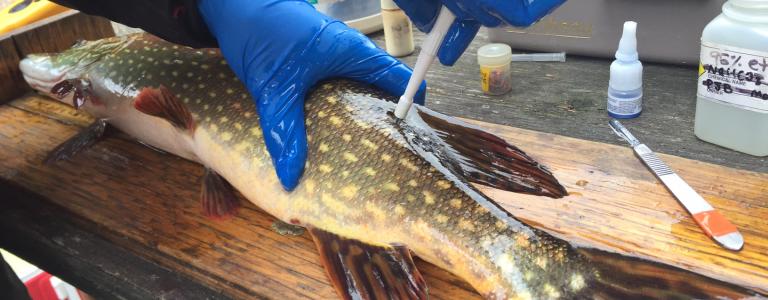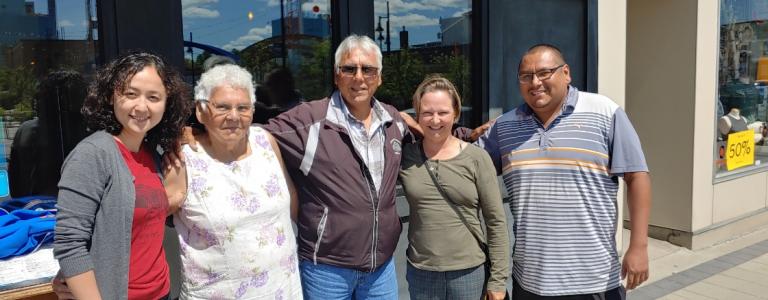Speaking Each Other’s Language
In Canada, First Nations people are at the highest risk of poisoning from consuming freshwater fish that have been contaminated with mercury (and its toxic form, methylmercury).
Mercury poisoning, or Minamata disease, comprises a wide range of physical and mental symptoms. These include hair loss, muscle weakness/paralysis, organ damage, loss of senses, depression, and even death.
First Nations communities in Canada often depend on freshwater fish for sustenance and are traditionally accustomed to catching their own fish.
It is therefore critical that we communicate the potentially harmful impact of mercury on fresh water and freshwater fish.
Historically, there has been little communication available in First Nations languages of the Western scientific understanding of the harmful nature of mercury accumulation in freshwater fish.
A Unique Approach to Western Science
For over 50 years, our very own Experimental Lakes Area has been conducting whole-ecosystem experiments on lakes and the impact of pollutants on lakes in Ontario, Canada. This is the only place in the world you can conduct this kind of research.
Some of this research involved intentionally introducing minute quantities of mercury to a freshwater lake over a given period and tracking the impact and build-up of mercury in the food web—including in freshwater fish. Unsurprisingly, the researchers discovered that the amount of mercury found in the fishes increased, but when they stopped adding mercury, the amount found in fishes decreased.
When it came to communicating the results, First Nations communities were top of the list, in the spirit of sharing knowledge and ensuring that we make our science accessible to all of our audiences.
We developed a six-minute animated video in Ojibwe (an Algonquian language spoken in parts of Canada) parsing our Western approach to mercury pollution and what we found.
We collaborated with Ojibwe language experts Elder Nancy Jones and Elder Don Jones, Ojibwe language teacher Jason Jones from Nigigoonsiminikaaning (Red Gut) First Nation in Ontario, and retired science instructor Bruce Townsend.
The translation process depended on innovative methods to develop new terms for concepts that do not currently have Ojibwe equivalents, such as “mercury.” The Ojibwe term for mercury we settled on was “Biiwaabikowaabo gaa-waawaageshkaag,” which literally means “liquid metal that shines.”
Jason Jones, our translator, said it best:
"Our language has vitality, with the ability to create new words."
Opening Our Doors to the World
Every step of the way, we collaborated with local First Nations in the development, translation, and communication of the video. For the translation, we collaborated with Nancy Jones, Don Jones, and Jason Jones of Nigigoonsiminikaaning (Red Gut) First Nation, and worked with Emma Bruyere of Couchiching First Nation, to voice the video.
This was a critical step in ensuring young First Nations voices were heard and amplified through the project.
For Emma, this wasn’t just about communicating the science of a particular issue—it was about preserving a language and its parent culture.
"I want to be working with the language my entire life… I know that I want to work with the language and help other people learn because of how much it's dying out."
As tends to be the case when we collaborate with local First Nations, the lessons proved to be a two-way street. Our deputy director, Pauline Gerrard, also learned a great deal from the process of translating our science into a different language.
"On a personal level, I've really learned a lot about the importance of water to Anishinaabe culture and the kind of personal responsibility that Indigenous people take for water management and water protection."
The video was well received by everyone from the CBC to the panel of judges at the 2020 Prospect Magazine Awards in London, who awarded the video the runner-up prize in the Medicine, Science & Technology category.
Next step? Integrating the research and its findings into Canadian school curricula. We are developing a lesson plan (including Ojibwe and English transcripts of the video, breakdown of sentences, neologisms, etc.) to supplement the video and act as an additional resource for all-level Ojibwe language learners or teachers to use. It will be available free of charge—all in the spirit of promoting the Ojibwe language and our understanding of mercury pollution.
Click here to learn more about how the world’s freshwater laboratory is collaborating with local First Nations communities to further our understanding of freshwater health. If you are interested in collaborating with IISD Experimental Lakes Area on any of this work, please contact Dilber Yunus at dyunusi@iisd-ela.org.
You might also be interested in
How We Do Things at IISD-ELA: Researching Mercury
This video explores the groundbreaking work that has been carried out at IISD-ELA to determine what impact mercury has on our water, and how we can best improve it.
Mercury: What it does to humans and what humans need to do about it
As the very first meeting of the Conference of the Parties to the Minamata Convention on Mercury takes place, we explain why mercury poses such a risk to humans and what IISD Experimental Lakes Area has discovered, and lay out what needs to happen next.
How the U.S. EPA is Changing its Mercury Policy
We explain how President Trump wants the EPA to changes its policies on mercury, and how it could impact the United States and potentially Canada.
Lake research video translated into Ojibway to help promote language as well as science
An environmental science video has been translated to Ojibway and the creators are hoping it sparks youth interest in science and language revitalization.

